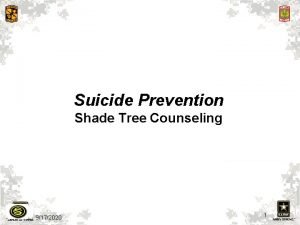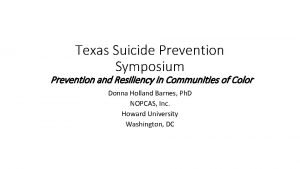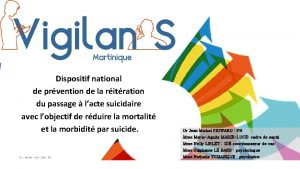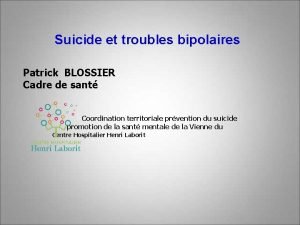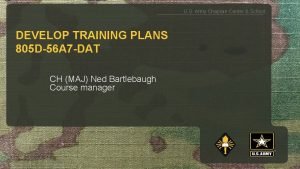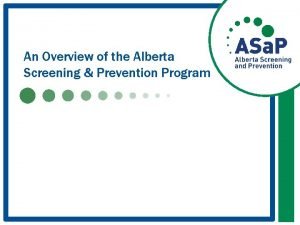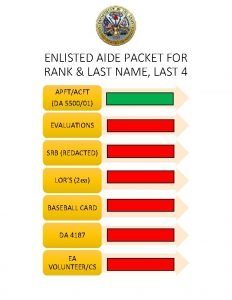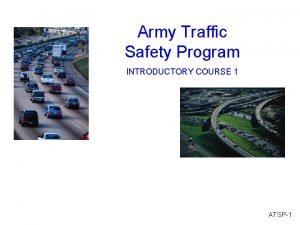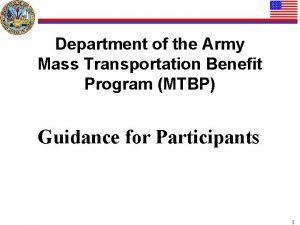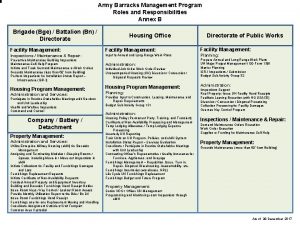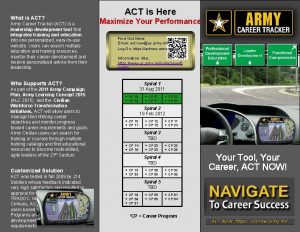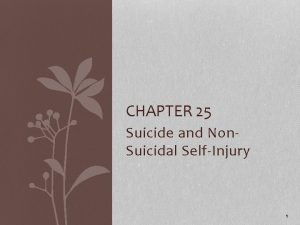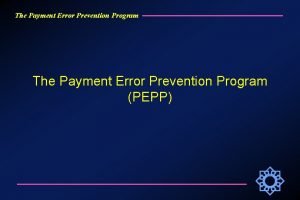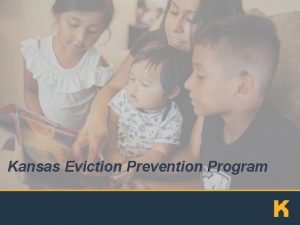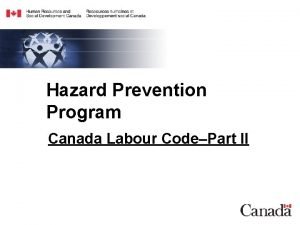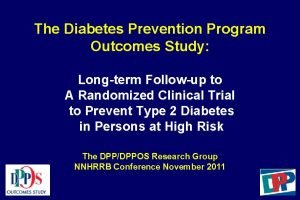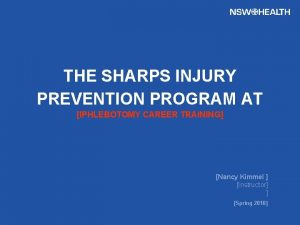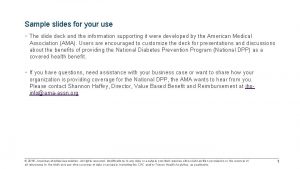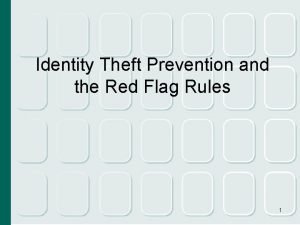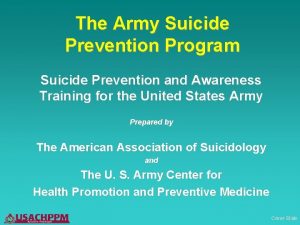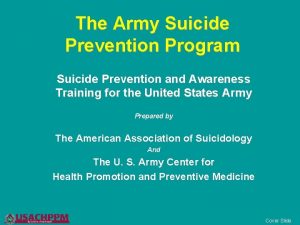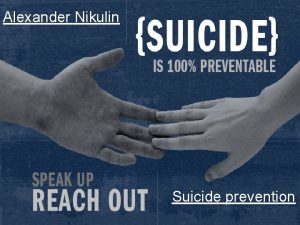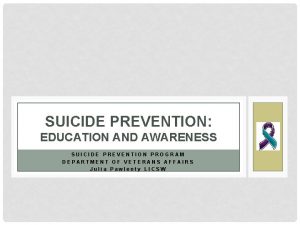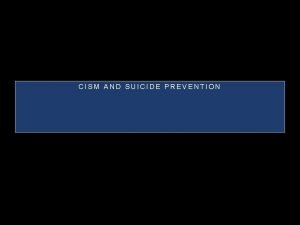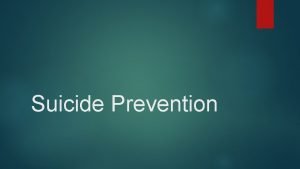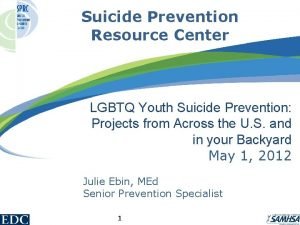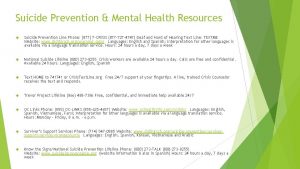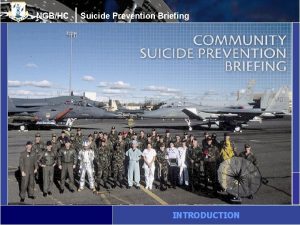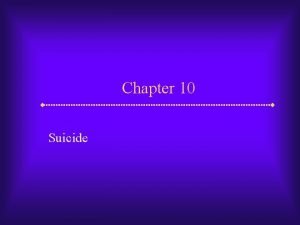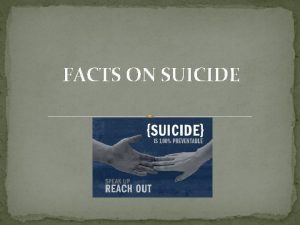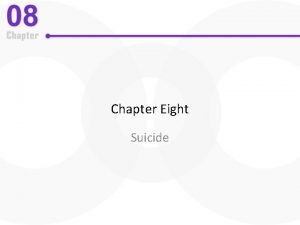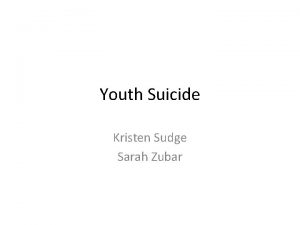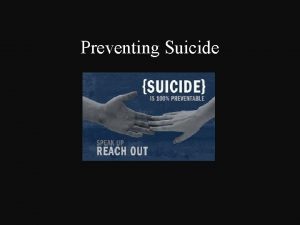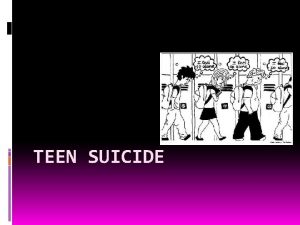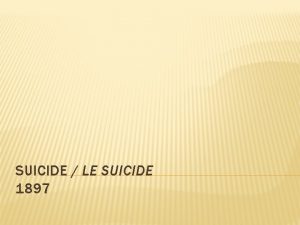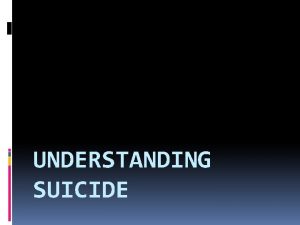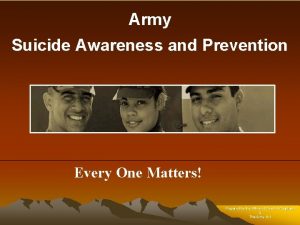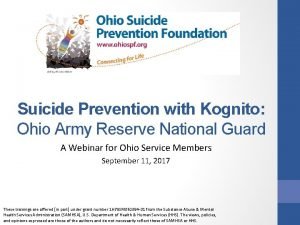The Army Suicide Prevention Program Suicide Prevention and





















































- Slides: 53

The Army Suicide Prevention Program Suicide Prevention and Awareness Training for the United States Army Prepared by The American Association of Suicidology And The U. S. Army Center for Health Promotion and Preventive Medicine Cover Slide

Enabling Learning Objectives 1. Describe primary, secondary and tertiary suicide prevention. 2. Identify personal and environmental protective factors. 3. Know information about local support resources and programs. OH 1 a, pg 7

Enabling Learning Objectives 4. Promote cohesion and a sense of belonging. 5. Destigmatize and encourage help seeking. OH 1 b, pg 7

The Army Suicide Prevention Program TERTIARY Recognizing and treating acute suicidal behavioral SECONDARY Recognizing the signs of Crisis and providing PRIMARY Caring support Anticipating people’s potential times of crisis and structuring pre-emptive support systems OH 2, pg 8

rim ar y (P Sp ot ) (S ec on da Se ry cu ) re (T er tia ry ) Sc re en Structure OH 3, pg 9

Personal Protective Factors • Easy temperament. • Previous experience with self-mastery, problem solving, crisis resolution. • Optimistic outlook. • Social/emotional competence. • High self esteem, self worth. OH 4 a , pg 9

Personal Protective Factors • Decision making, problem solving skills. • Sense of personal control, self efficacy. • Sense of belonging to a group and/or organization. • High and realistic expectations. • High spiritual resiliency. OH 4 b, pg 9

Environmental Protective Factors • Strong family relationships. • Models of healthy coping. • Encouragement of participation. • Opportunities to make significant contributions OH 5 a, pg 9

Environmental Protective Factors • Available social supports. • Available helping resources. • Healthy spiritual/religious affiliation. • Cultural and religious beliefs against suicide and in support of self-preservation. OH 5 b, pg 9

Support • The Reasons for Living Inventory, Linehan, Goodstein, Nielsen & Chiles (1983) • Spirituality and Resilience Assessment Packet, Version 4. 2, Kass (2000) OH 6, pg 9

Connections save lives. • Spiritual connectedness • Unit cohesiveness OH 7, pg 10

Seeking help is a sign of effectively dealing with problems, and of strength rather than weakness. OH 8, pg 11

A good leader does not expose those under his/her command to unnecessary risk. OH 9, pg 11

Support • Promote a norm of mutual support among all military personnel: we are our brother’s keepers! • Pay attention to warning signs and respond to those who need help. OH 10 a, pg 11

Support • Pay close attention to the personal needs of your people, and be on the lookout for signs of stress. • Communicate in your words and actions that it is not only acceptable, but a sign of strength, to recognize life problems and get help to deal with them constructively. OH 10 b, pg 11

Support • Support and protect to the fullest extent possible those courageous people who seek help early, before a crisis develops. OH 10 c, pg 11

Support • Create a responsive, caring, and responsible community where individuals are motivated to seek help with personal struggles without fear of stigmatization. OH 10 d, pg 11

Support • Foster a social climate in your unit that communicates to everyone, “you belong here”. OH 10 e, pg 11

Enabling Learning Objectives • Understand the benefits of gated screening. • Be informed about the confidentiality of screening results. • Be informed about secondary screening instruments. OH 1, pg 14

Screen • The Army Structure makes screening viable. • Screening must be gated. • The Suicide Prevention Task Force collects and reports anonymous data. OH 2, pg 15

Screen Goldberg Well-Being Scale (1972) Please circle the most appropriate response: In the last two weeks have you: Not at all 1 Been able to concentrate on whatever you’re doing? 1 2 3 4 2 Lost much sleep over worry? 1 2 3 4 3 Felt that you are playing a useful part in things? 1 2 3 4 4 Felt capable of making decisions about things? 1 2 3 4 5 Felt constantly under strain? 1 2 3 4 6 Felt that you couldn’t overcome your difficulties? 1 2 3 4 7 Been able to enjoy your normal day-to-day activities? 1 2 3 4 8 Been able to face up to your problems? 1 2 3 4 9 Been feeling unhappy and depressed? 1 2 3 4 10 Been losing confidence in yourself? 1 2 3 4 11 Been thinking of yourself as a useless person? 1 2 3 4 12 Been feeling reasonably happy, all things considered? 1 2 3 4 No more than usual A little more than usual A lot more than usual OH 3, pg 16

Screen – Goldberg Well-being Scale information will be disclosed only to the individual and will be used only to assess and assist personnel during of times of distress – Unit Trends may be reported to the Unit Commander as a gauge of his/her unit wellbeing OH 4, pg 17

Screen • Multidimensional Health Profile (MHP) Ruehlman, Lanyon & Karoly • Life Stressors and Social Resources Inventory (LISRES-Adult), Moos OH 5, pg 17

Gatekeeper Lesson 1 All Personnel OH 1, pg 23

Gatekeeper Lesson 1 Enabling Learning Objectives 1. Understand The Suicide Model. 2. Answer general questions about suicide. 3. Identify common precipitants of suicide. 4. Identify symptoms of depression. 5. Identify myths about suicide. 6. Identify warning signs of suicide. 7. Take appropriate action in response to atrisk individual. OH 2 , pg 23

Main Points • The Suicide Model. • What is suicide? • Why should we know about suicide? • Why do people commit suicide? • Some stressful situations that can trigger suicidal feelings in the Army. • Who commits suicide? OH 3 a, pg 24

Main Points • Groups with special problems that can cause suicidal feelings. • Misconceptions about suicide. • How can you tell if someone is thinking about committing suicide? • Common symptoms of depression & hopelessness. • Referral procedures. OH 3 b, pg 24

Suicide Model* Prevent The disorder** before it occurs No access to method, no acceptance of suicide, support/ emotional expression, & seeks treatment Inhibition Survival Disorder** (**Depression, anxiety, and substance abuse) Stress Event (Relationship losses, or career, legal and financial trouble) Mood Change (Anger, anxiety, hopelessness, depression) Facilitation Suicide Access to method, acceptance of suicidal behavior, isolation, impulse, loss of close relationship by suicide, & avoids treatment *Based on a model by David Shaffer, M. D. , Columbia U. OH 4, pg 25

The Problem of Suicide • Serious suicidal thoughts or threats. • Self destructive acts • Attempts to harm, but not kill oneself. • Attempts to commit suicide. • Completed suicide. OH 5, pg 25

Categories of Suicide • Lack of control related to needs for achievement, order, or understanding. • Problems with self-image related to frustrated needs for affiliation OH 6 a, pg 26

Categories of Suicide • Problems with key relationships related to grief and loss in life. • Excessive anger, rage, and hostility. OH 6 b, pg 26

Numbers and rates per 100, 000 of Suicides in the Army 1990 – 102 (13. 5) 1995 – 78 (14. 2) 1991 – 102 (13. 1) 1996 – 68 (13. 8) 1992 – 87 (13. 5) 1997 – 56 (11. 5) 1993 – 90 (15. 5) 1998 – 68 (14. 4) 1994 – 80 (14. 5) 1999 – 65 (13. 8) OH 7, pg 28

Gatekeeper Lesson 2 Officers & NCOs OH 1, pg 41

Gatekeeper Lesson 2 Enabling Learning Objectives 1. Inquire about suicide. 2. Respond to phone callers. 3. Obtain help for suicidal individuals. OH 2, pg 41

Responding to Statements or Threats • Stay calm. • Send someone for help. • Do not leave alone. • Buy time. OH 3 a, pg 42

Responding to Statements or Threats • Acknowledge. • Listen. • Convey. OH 3 b, pg 42

Responding to Statements or Threats • Secure. • Note the time. • Take action. OH 3 c, pg 42

Asking About Suicide • Review your evidence. • Inquire or state about feelings. • Persist. • “Sometimes” approach. OH 4 a, pg 43

Asking About Suicide • Ask directly. • Get help. • Convey concern. OH 4 b, pg 43

The only thing that will save a human life is a human relationship. OH 5, pg 47

Gatekeeper Lesson 3 Formal Gatekeepers OH 1, pg 50

Gatekeeper Lesson 3 Enabling Learning Objectives • Identify Risk Factors for Suicide. • Conduct Basic Risk Assessment. OH 2, pg 50

Risk Assessment Questions 1. Have you been thinking of killing yourself? 2. What has happened that makes life not worth living? 3. How will you do it? OH 3 a, pg 52

Risk Assessment Questions 4. How much do you want to die? 5. How much do you want to live? 6. How often do you have these thoughts? 7. When you think of suicide, how long do the thoughts stay with you? OH 3 b, pg 52

Risk Assessment Questions 8. Have you ever attempted suicide? 9. Have you been drinking heavily lately or taking drugs? 10. Has anyone in your family committed or attempted suicide? 11. Is there anyone or anything to stop you? 12. On a scale of 1 to 10, what is the probability that you will kill yourself? OH 3 c, pg 52

Secure Health Care Professionals OH 1, pg 56

Enabling Learning Objectives 1. Become knowledgeable about Army suicide policies and procedures. 2. Conduct Advanced Risk Assessment. OH 2, pg 56

Local policies and procedures set by the Suicide Prevention Task Force • An individual suspected of being at risk for suicide. • An individual who is talking about/threatening suicide. OH 3 a pg 57

Local policies and procedures set by the Suicide Prevention Task Force • An individual who attempts suicide. • A completed suicide. OH 3 b, pg 57

Steps in Suicide Assessment 1. Set the stage for the interview. 2. Assess for risk factors and warning signs for suicide. 3. Inquire about suicidal ideation. 4. Determine the level of suicide risk. OH 4, pg 58

Assessing the Suicide Plan • Perturbation. • Cognitive construction. • Intentionality. • Lethality of the plan. OH 5, pg 58

Assessing the Suicide Plan • Specificity. • Method or means. • Availability & accessibility of means. OH 6, pg 59

T = Thoughts I = Intent P = Plan M = Means OH 7, pg 60
 Army suicide prevention situational questions
Army suicide prevention situational questions Army suicide prevention training
Army suicide prevention training Primary prevention secondary prevention tertiary prevention
Primary prevention secondary prevention tertiary prevention Mad acronym suicide prevention
Mad acronym suicide prevention Glencoe health chapter 5
Glencoe health chapter 5 Suicide chain teach
Suicide chain teach Texas suicide prevention symposium
Texas suicide prevention symposium Suicide prevention sink
Suicide prevention sink Prévention du suicide
Prévention du suicide Suicide prevention month quotes
Suicide prevention month quotes Vivien blossier
Vivien blossier Army central army registry
Army central army registry Alberta screening and prevention program
Alberta screening and prevention program Aecp fy 2023
Aecp fy 2023 Army star program
Army star program Gpc program army gpc guidebook
Gpc program army gpc guidebook Army national guard ged plus program
Army national guard ged plus program Da form 5500
Da form 5500 Army traffic safety training program
Army traffic safety training program Army mass transportation benefit program
Army mass transportation benefit program Army barracks management program
Army barracks management program Act login army
Act login army Army eo regulation
Army eo regulation Total army sponsorship program counseling
Total army sponsorship program counseling Chapter 25 suicide and nonsuicidal self injury
Chapter 25 suicide and nonsuicidal self injury Payment error prevention program
Payment error prevention program Kshousingcorp/eviction-prevention-program
Kshousingcorp/eviction-prevention-program Hazard prevention program
Hazard prevention program Diabetes prevention program outcomes study
Diabetes prevention program outcomes study Needle stick injury
Needle stick injury Diabetes prevention program ppt
Diabetes prevention program ppt Identity theft prevention program
Identity theft prevention program Counterfeit parts prevention program as5553
Counterfeit parts prevention program as5553 Hát kết hợp bộ gõ cơ thể
Hát kết hợp bộ gõ cơ thể Ng-html
Ng-html Bổ thể
Bổ thể Tỉ lệ cơ thể trẻ em
Tỉ lệ cơ thể trẻ em Chó sói
Chó sói Chụp phim tư thế worms-breton
Chụp phim tư thế worms-breton Chúa sống lại
Chúa sống lại Các môn thể thao bắt đầu bằng tiếng nhảy
Các môn thể thao bắt đầu bằng tiếng nhảy Thế nào là hệ số cao nhất
Thế nào là hệ số cao nhất Các châu lục và đại dương trên thế giới
Các châu lục và đại dương trên thế giới Công của trọng lực
Công của trọng lực Trời xanh đây là của chúng ta thể thơ
Trời xanh đây là của chúng ta thể thơ Cách giải mật thư tọa độ
Cách giải mật thư tọa độ Phép trừ bù
Phép trừ bù độ dài liên kết
độ dài liên kết Các châu lục và đại dương trên thế giới
Các châu lục và đại dương trên thế giới Thơ thất ngôn tứ tuyệt đường luật
Thơ thất ngôn tứ tuyệt đường luật Quá trình desamine hóa có thể tạo ra
Quá trình desamine hóa có thể tạo ra Một số thể thơ truyền thống
Một số thể thơ truyền thống Cái miệng bé xinh thế chỉ nói điều hay thôi
Cái miệng bé xinh thế chỉ nói điều hay thôi Vẽ hình chiếu vuông góc của vật thể sau
Vẽ hình chiếu vuông góc của vật thể sau
